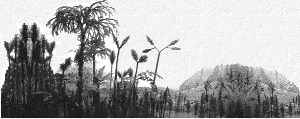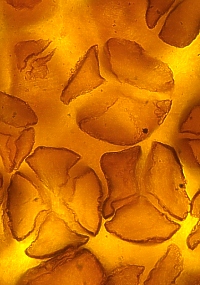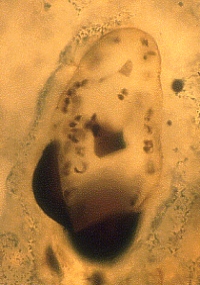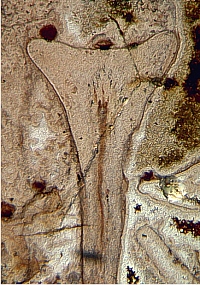 |
|
 |

Spore tetrads in sporangium |

Germinating spore |
The Rhynie Chert also provided detailed information on the life cycles of Aglaophyton and two other early land plants. The alternation of generations for fossil plants was first demonstrated on the basis of anatomically preserved Rhynie Chert material. The free-growing male gametophytes of Aglaophyton consist of an axis which is terminally widened to form a cup which bears the antheridia. The anatomy of the axis of the gametophyte is very similar to that of the sporophyte. Although the former are smaller, they have the same type of stele, anatomy and stomata. The antheridia have a short stalk and are rounded to inverted heart-shaped in longitudinal section. Contrary to the antheridia of extant plants they have a short column of sterile tissue in the centre. The antherida produced large masses of ca. 20 µm long and 2 µm thick, spirally coiled sperm cells. Aglaophyton antheridia apparently opended when mature after having been in contact with (rain) water. At least at this stage the free-swimming sperm cells needed water to reach the egg cells of the female gametophytes. The female gametophytes have been found but not yet been formally described. They have archegonia with a deeply sunken egg chamber and a long neck. The connection with the outer world is via a narrow neck channel. The gross morphology of the female gametophyte is still insufficiently known. Another Rhynie Chert plant - sporophyt Horneophyton lignieri / gametophyte: Langiophyton mackiei - has an axis with a terminal disc-shaped structure with a number of tube-like outgrowths bearing the archegonia. Thanks to the discovery of germinating spores in various stages of development and the development of the gametophytes, the life cycle of Aglaophyton can be reconstructed in great detail. An overview of the currently known Rhynie Chert gametophytes is given in the table below: |

Male gametophyte with antheridia |

Release of sperm from antheridium |
|
| Some stages of the life cycle of Aglaophyton major | ||
|
|
|
|
|
|
|
|
|
|
|
|
|
|
|
|
|
|
|
|
| © Forschungsstelle für Paläobotanik, Westfälische Wilhelms-Universität Münster |
April 2000
|